Raise3D: 3D printing replaces traditional shoe manufacturing
Gradually, 3D printing penetrates into all areas of our lives. In addition to the usual areas, such as prototyping, the creation of architectural models, parts, master models, household items, etc., 3D printers are used for other purposes. The production of shoes using additive technologies is not a new direction, but at the moment it is not widespread. There are companies that use 3D printers as an additional element to the main production - the creation of accessories, jewelry, design elements for shoes. Some people make shoes on a turnkey 3D printer from insole to sole.
Among Raise3D customers, there are two companies that use 3D printers to produce specialized sneakers and make intelligent insoles. We will tell their stories.
Creation of specialized sports shoes on Raise3D 3D printers

At 25, Oliver Brossmann has already become an entrepreneur and developer of unique sports shoes. As a child, he, like many boys, dreamed of becoming a professional footballer. But after a knee surgery in high school, I had to say goodbye to my dream. During the recovery period, Brossmann began to study approaches to running and exercises with minimal strain on the joints and knees. In college, Brossmann, in addition to basic subjects, attended a couple of computer science and prototyping classes. Pursuing the goal of putting his business idea into practice and putting his knowledge into practice, Oliver left college and set to work on his own startup, Prevolve. This project was developed from scratch with the help of small investments from a private investor. Oliver’s startup at the moment is Oliver himself,
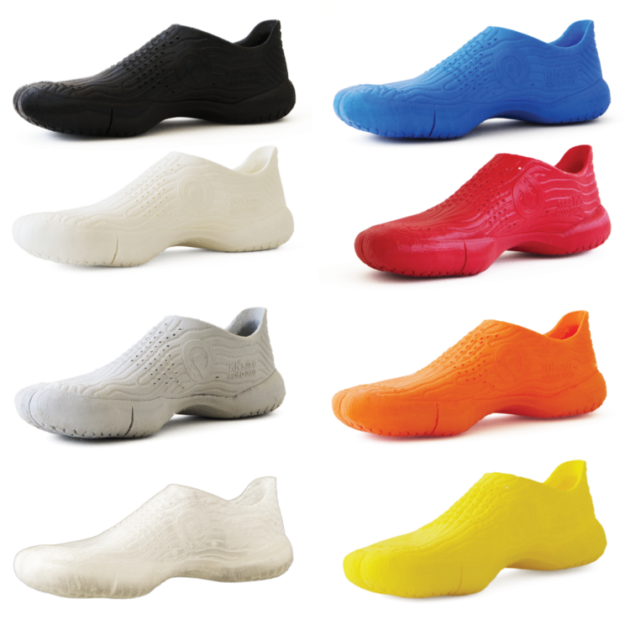
After 3 years, Brossmann officially launched his company's first product, called BioRunners. The shoes were created on the BioFusion platform, developed by Oliver for 3D printing of special sports shoes. In combination with a professional foot scanner that performs an accurate scan, the product became better and better with each iteration.
Prevolve shoes are printed in thermoplastic polyurethane, a durable and abrasion resistant material. In the Prevolve online store, customers can choose the appropriate color, thickness of shock absorber and tread - for trail or street running.
“Each pair of shoes is designed for a specific foot and, accordingly, the shape of each shoe is unique. I’m still thinking about a design upgrade to make running shoes more attractive and increase productivity, ”says Oliver.
Printing Prevolve shoes on a 3D printer, depending on the size, takes from 20 to 30 hours. Oliver uses Raise3D printers, the construction area of which is optimally sized for printing sneakers.
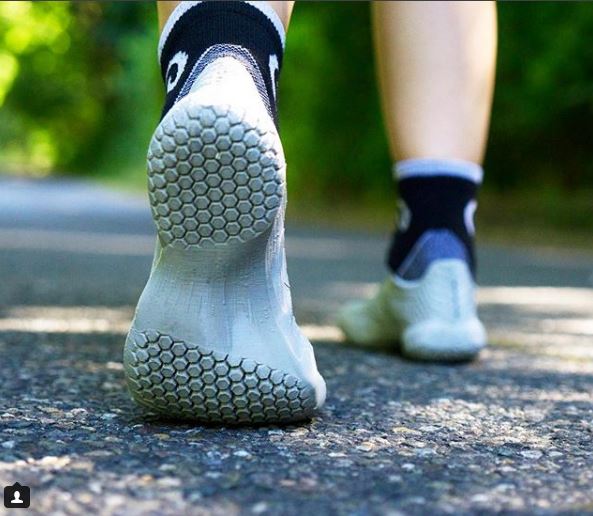
Prevolve shoe buyers are athletes, professionals and amateurs, as well as people with foot problems (different foot sizes, flat feet, etc.). Shoes printed on a 3D printer are the most cost-effective and quickest to manufacture option compared to orthopedic ones made to order in a traditional way.
3D printing of smart insoles on Raise3D N2
Dr. Roy Cheng of Gait & Motion Analysis Lab - creator of smart smart insoles printed on a 3D printer. Roy himself is fond of running and wanted to buy smart insoles for himself, but the expensive market value made him think about implementing this project himself.
Roy specializes in biomechanics of running, the effectiveness of preventive devices for athletes, and conducting trainings on rehabilitation and injury prevention, and received large research grants for his developments.
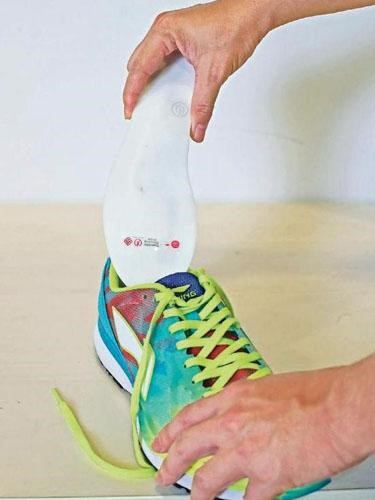
Both creating a custom insole for an individual order and developing a smart insole using traditional methods is a complicated and expensive process, and the target audience is very narrow.
The disadvantages of the traditional method that Roy Cheng and his team used in the beginning:
The traditional method of production is:
Using Raise3D N2, the company was able to:
Production process: The
list of equipment includes: a computer, a scanner, a printer instead of a thermoforming and grinding machine.
Smart insoles are made up of electronic sensors and a thermoplastic base. The production process can be divided into three main stages:
- Scanning of the foot;
- Modeling of the insole and the location of the sensors / design;
- Printing / installation of electronics.
First, the feet are scanned, the result of the scan will be used to simulate the insoles. Using the visualized scan data in the simulation software, you can easily find the right solution for the location of the sensors on the insole, taking into account its shape and the scanned model of the leg. Two pressure sensors are placed around the heel and metatarsal bone. Bluetooth modules are installed in the fold area.
Using a visualized model and 3D printing, Roy maximized the protection of the electronics located on the insole. It was possible to do this by correctly placing all the components on the insole and controlling the hardness of the insole by selecting the desired filament and the percentage of filling the model when printing. All electronic components are placed between the layers.
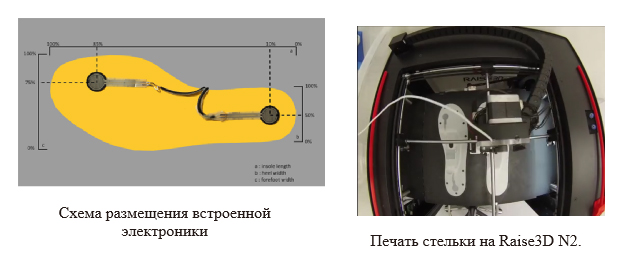
Using 3D printing, Roy was able to remove most of the insole manufacturing processes. Raise3D N2 can build a finished product from and to with an individual insole shape and a specific arrangement of elements, and will automatically leave space for the circuit. After installing the circuits, the printer completely closes the electronics, printing the upper additional layers.
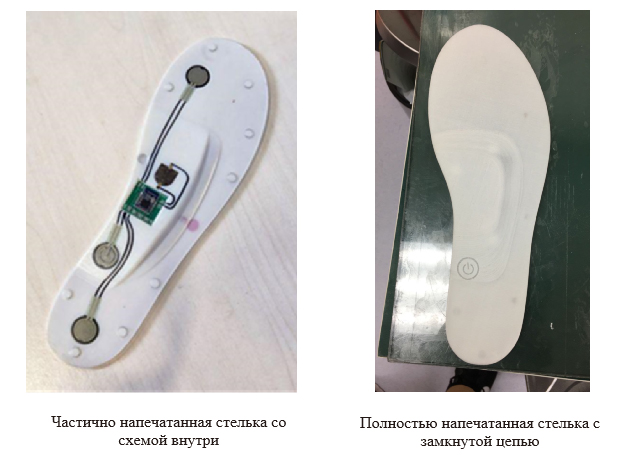
By automating this process, labor costs, equipment costs, and lead time are reduced.
Most importantly, Raise3D allows you to configure the printing of the insole and the layout of the scheme in one print session. As a result, the cost of the insole is significantly reduced, the manufacturing time is reduced from 2 weeks to 5 days (or less).
Join us in the social. networks to keep abreast of the latest developments:
Facebook
VKontakte
YouTube
Company team Tsvetnoy Mir
Among Raise3D customers, there are two companies that use 3D printers to produce specialized sneakers and make intelligent insoles. We will tell their stories.
Creation of specialized sports shoes on Raise3D 3D printers

At 25, Oliver Brossmann has already become an entrepreneur and developer of unique sports shoes. As a child, he, like many boys, dreamed of becoming a professional footballer. But after a knee surgery in high school, I had to say goodbye to my dream. During the recovery period, Brossmann began to study approaches to running and exercises with minimal strain on the joints and knees. In college, Brossmann, in addition to basic subjects, attended a couple of computer science and prototyping classes. Pursuing the goal of putting his business idea into practice and putting his knowledge into practice, Oliver left college and set to work on his own startup, Prevolve. This project was developed from scratch with the help of small investments from a private investor. Oliver’s startup at the moment is Oliver himself,

After 3 years, Brossmann officially launched his company's first product, called BioRunners. The shoes were created on the BioFusion platform, developed by Oliver for 3D printing of special sports shoes. In combination with a professional foot scanner that performs an accurate scan, the product became better and better with each iteration.
Prevolve shoes are printed in thermoplastic polyurethane, a durable and abrasion resistant material. In the Prevolve online store, customers can choose the appropriate color, thickness of shock absorber and tread - for trail or street running.
“Each pair of shoes is designed for a specific foot and, accordingly, the shape of each shoe is unique. I’m still thinking about a design upgrade to make running shoes more attractive and increase productivity, ”says Oliver.
Printing Prevolve shoes on a 3D printer, depending on the size, takes from 20 to 30 hours. Oliver uses Raise3D printers, the construction area of which is optimally sized for printing sneakers.

Prevolve shoe buyers are athletes, professionals and amateurs, as well as people with foot problems (different foot sizes, flat feet, etc.). Shoes printed on a 3D printer are the most cost-effective and quickest to manufacture option compared to orthopedic ones made to order in a traditional way.
3D printing of smart insoles on Raise3D N2
Dr. Roy Cheng of Gait & Motion Analysis Lab - creator of smart smart insoles printed on a 3D printer. Roy himself is fond of running and wanted to buy smart insoles for himself, but the expensive market value made him think about implementing this project himself.
Roy specializes in biomechanics of running, the effectiveness of preventive devices for athletes, and conducting trainings on rehabilitation and injury prevention, and received large research grants for his developments.

Both creating a custom insole for an individual order and developing a smart insole using traditional methods is a complicated and expensive process, and the target audience is very narrow.
The disadvantages of the traditional method that Roy Cheng and his team used in the beginning:
- High cost of production;
- Only large print runs of production;
- Inaccurate result in manual production;
- The term of use is 1 year.
The traditional method of production is:
- casting molds from foam, silicone or gypsum (often by hand);
- thermoforming of the insole according to the footprint;
- correction of insoles and completion of work.
Using Raise3D N2, the company was able to:
- Reduce production time by 64.29%
- Reduce production value by 99.5%
- Develop accurate and perfect models.
Production process: The
list of equipment includes: a computer, a scanner, a printer instead of a thermoforming and grinding machine.
Smart insoles are made up of electronic sensors and a thermoplastic base. The production process can be divided into three main stages:
- Scanning of the foot;
- Modeling of the insole and the location of the sensors / design;
- Printing / installation of electronics.
First, the feet are scanned, the result of the scan will be used to simulate the insoles. Using the visualized scan data in the simulation software, you can easily find the right solution for the location of the sensors on the insole, taking into account its shape and the scanned model of the leg. Two pressure sensors are placed around the heel and metatarsal bone. Bluetooth modules are installed in the fold area.
Using a visualized model and 3D printing, Roy maximized the protection of the electronics located on the insole. It was possible to do this by correctly placing all the components on the insole and controlling the hardness of the insole by selecting the desired filament and the percentage of filling the model when printing. All electronic components are placed between the layers.

Using 3D printing, Roy was able to remove most of the insole manufacturing processes. Raise3D N2 can build a finished product from and to with an individual insole shape and a specific arrangement of elements, and will automatically leave space for the circuit. After installing the circuits, the printer completely closes the electronics, printing the upper additional layers.

By automating this process, labor costs, equipment costs, and lead time are reduced.
Most importantly, Raise3D allows you to configure the printing of the insole and the layout of the scheme in one print session. As a result, the cost of the insole is significantly reduced, the manufacturing time is reduced from 2 weeks to 5 days (or less).
Join us in the social. networks to keep abreast of the latest developments:
VKontakte
YouTube
Company team Tsvetnoy Mir
